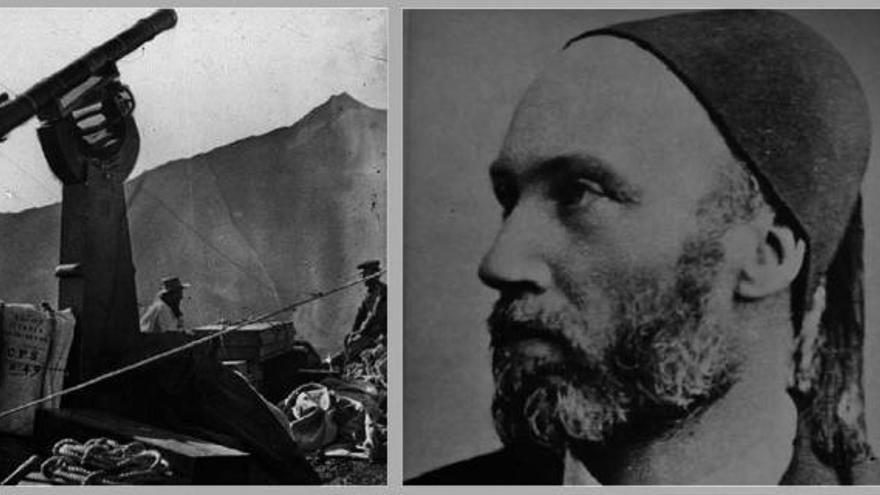
At the age of six, Charles Piazzi Smith (Naples, 1819- England, 1900) moved to England as his father had been assigned to the Bedford Observatory. Ten years later he was already working as an assistant at the Cape of Good Hope Astronomical Observatory, where he was able to study Halley’s Comet. In 1845 he was appointed Astronomer Royal for Scotland and Professor of Astronomy at the University of Edinburgh. He belonged to the Munich and Palermo academies of sciences, and was an honorary member of numerous scientific and cultural societies.
In 1856 he moved to Tenerife because he considered that when making his astronomical observations in the Teide, they would benefit by removing the bottom third or fourth of the atmosphere. For this he had the invaluable help of Robert Stephenson, member of the British Parliament, who put his ship Titania and a crew of 16 men at his disposal; that of the Hon. Charles Wood, who gave him £500 so that he could carry out the experiment; that of George Biddell Airy, director of the Greenwich Observatory; and that of Mr. Pattinson, Astronomer Royal of Newcastle, who provided him with the great Equatorial telescope, a Sheepshank telescope, actinometers, magnetometers, radiation thermometers, barometers, other telescopes, chronometers, and polarization apparatus. He also received the collaboration of the Ministry of the Navy, the Royal Society of London, the Royal Astronomical and the British Association.
On board the ‘Titania’
Having received permission from the Spanish authorities, Piazzi Smith left Southampton on June 24, 1856, aboard the Titania, captained by Loving Cooke, arriving at the Port of Santa Cruz de Tenerife on July 8 of that year. At the dock they were received by the authorities Canary Islands and the British consul in the Archipelago, Henry John Murray, who made everything necessary for his work available to him. The ship continued towards the Port of La Orotava, where it would unload the heavy and valuable instruments it was transporting, while Piazzi Smyth and his young wife, Jessie Anne Duncan, whom he had just married, toured the town and spent the night in Santa Cruz, leaving at next day to the North.
On July 14, 1856, Charles Piazzi Smyth began the ascent of Mount Teide. He was accompanied by his wife, the guide (Manuel), the servant (Manuel), the mule drivers with their 27 pack animals (mules and horses) and several members of the ship’s crew. In the Cañadas del Teide he established two observation stations, one on the Guajara mountain, where the Parador de Turismo is located today, and the other in the Altavista refuge, at an altitude of 3,300 meters. In Altavista they built a wall 55 meters long, 1.20 wide and 1.80 high, forming a closed enclosure that protected them from the north, west and south winds. There they built the cells for the accommodation and Pattinson’s great Equatorial telescope.
As this place had perfect zenithal vision and had the most diaphanous of atmospheres, during 28 days he was able to observe the difficult stars B and C of the Andromeda range, as well as the most opaque or difficult stars to a practical eye. He was also able to see the small division of Saturn’s ring, the surface of Jupiter or extraordinary views of the Moon. Thanks to the extraordinary increase in the space penetration capacity of the telescope, which went from the tenth to the fourteenth magnitude, the stars not only appeared brighter, but also improved their definition. As a result of these investigations, two mountains on the Moon would bear the names of Teide and Tenerife.
To supply themselves with water, they used the Ice Cave. The first time they entered they did so through a one meter square hole, then descended by a rope with intertwined knots to place their feet. Inside the cave they found a ring fence of snow 1 meter high and 2 meters wide, a large surface of wonderfully pure water, and a large patch of snow that extended to the innermost walls of the cave.
In the Ice Cave
So that Jessie Anne Duncan could access the cave and reveal the collodion plates of the photos taken with the stereoscopic machine, the Titania’s carpenter built a ladder, which was left there in honor of the snowfields that in summer times supplied ice to the inhabitants of Santa Cruz, La Laguna, La Orotava and Gran Canaria. During the 37 days that she was in Guajara and the 26 that she remained in Altavista, she received the collaboration of different personalities from Tenerife, who sent them meat, fish, milk or eggs.
Return to Santa Cruz
Piazzi Smyth would return to Santa Cruz on September 26 to dismantle the tide gauge that he had left on the dock the day of his arrival, in order for Captain Loving Cooke to make accurate and continuous meteorological observations.
The next day, leaving Tenerife for England, he writes: «When night falls and our last glimpse of the Peak remains high in the sky, we wonder how long the enlightened world will delay the installation of an observation station in Las Cañadas. del Teide, which promises so much for the best advancement of the most sublime of Sciences». We would have to wait a century until the Izaña Observatory was inaugurated, considered one of the most important in the world by the international scientific community.
The experiments carried out by Piazzi Smyth in Tenerife began to be published in the English newspaper Daily News from October 20, 1856. Two years later, the author would publish in London an extensive book entitled Teneriffe, an astronomer’s experiment (Tenerife, the experiences of an astronomer), illustrated with 20 stereoscopic photographs taken by his wife; This book was owned by my dear friend and predecessor in my position, Luis Cola Benítez, and which was translated into Spanish by José Luís García Pérez and Emilio Abad Ripoll, members of the Friends of July 25 Gathering.















